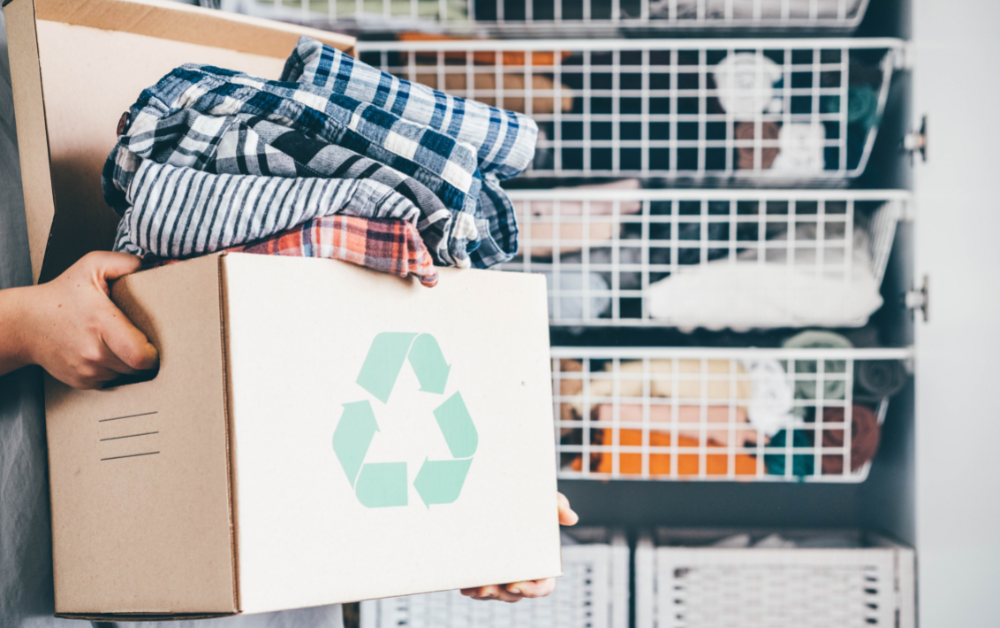Textile Recycling
by ajones | Nov 9, 2022 | Fashion, Recycling, fiber-to-fiber, waste | No Comments

Textile waste continues to be a growing problem. This is caused by the popularity of fast fashion, micro-trends spread through social media, and consumerism. In Europe, more than 15 kilograms of textile waste is generated per person, with 85% of textile waste made up of discarded clothes and home textiles (Hedrich et al., 2022). Currently most of it ends up incinerated or dumped in landfills, as less than 1% of such waste is fiber-to-fiber recycled (Smits, 2022, August 18).
In the United States, the Environmental Protection Agency (EPA) found that Americans generated 17 million tons of textile waste in 2018, with only 2,510 tons recycled and 11.3 million tons sent to landfills. This waste has grown exponentially since first being tracked in 1960, when 1.76 million tons were generated (EPA, 2022). According to the San Francisco Goodwill, basically one garbage truck of textiles is sent to a landfill every second (Cotton Inc., 2020).
Thankfully there are multiple ways to address the problem, such as reducing overproduction and overconsumption and extending product lifetimes. Another very sustainable, scalable solution is textile recycling (Hedrich et al., 2022). Recycled materials are those that would have been disposed of but have been reprocessed as material input instead of using new primary material. Such materials can include garments, as well as plastic bottles, yarns, fishing nets, wool carpets, and other industrial waste (Smits, 2022, June 23).
Advances in global fiber-to-fiber recycling
Right now most recycled polyester isn’t made from recycled garments but from bottles. While this is a step in the right direction, to reach circularity, the industry must improve textile-to-textile, or fiber-to-fiber, recycling. The new EU strategy for Sustainable and Circular Textiles encourages businesses to prioritize such recycling efforts, and there are various technologies being developed to aid with implementing this on a larger scale (Smits, 2022, June 23).
Post-industrial, pre-consumer, and post-consumer materials can all be used in fiber-to-fiber recycling (Smits, 2022, June 23).
- Post-industrial textile waste: generated during textile production, also called clips or scraps
- Pre-consumer textiles: finished garments not be sold or used, such as overstock
- Post-consumer waste: material generated by the consumer, or end user, that can no longer be used as intended due to wear, etc.
A recent McKinsey report, “Scaling textile recycling in Europe–turning waste into value,” anticipates that fiber-to-fiber recycling could reach 18%-26% of gross textile waste in 2030. With continued innovation, McKinsey estimates that 70% of textile waste could be fiber-to-fiber recycled. To reach these goals, there must be improvements in scale, collaboration, funding, investments, and a push from the public sector (Hedrich et al., 2022).
Consumers’ role
While much of the ability and responsibility lies with the industry, consumers play a role and need to be informed. A Lifestyle Monitor survey found that 68% of consumers have never heard of circular fashion (clothing that can be reused or recycled into new garments), and 11% believe that it refers to fashions going in and out of style (Cotton Inc., 2022, September 14). The good news is that 75% of consumers state an interest in apparel recycling as a fashion industry sustainability initiative, and 34% say they will pay more for clothes produced from recycled textiles (Cotton Inc., 2022, September 14).
Raising awareness, supporting further innovation, and working together will lead to more sustainable, increased textile recycling that benefits all.
References
Cotton Inc. (2020, November 11). Here’s how textile recycling is redefined for new era. Lifestyle Monitor. https://lifestylemonitor.cottoninc.com/heres-how-textile-recycling-is-redefined-for-new-era/
Cotton Inc. (2022, September 14). How fashion looks inward as climate week approaches. Lifestyle Monitor. https://lifestylemonitor.cottoninc.com/how-fashion-looks-inward-as-climate-week-approaches/
EPA. (2022, June 22). Textiles: Material-Specific Data. EPA.gov. https://www.epa.gov/facts-and-figures-about-materials-waste-and-recycling/textiles-material-specific-data
Hedrich, S., Janmark, J., Strand, M., Langguth, N., & Magnus, K-H. (2022, July 14). Scaling textile recycling in Europe—turning waste into value. McKinsey. https://www.mckinsey.com/industries/retail/our-insights/scaling-textile-recycling-in-europe-turning-waste-into-value
Smits, H. (2022, June 23). When talking about recycled materials, origin matters. Sourcing Journal. https://sourcingjournal.com/topics/raw-materials/recover-recycled-fibers-cotton-textiles-circularity-polyester-plastic-bottle-349916/
Smits, H. (2022, August 18). Momentum grows for scaling textile recycling in Europe. Sourcing Journal. https://sourcingjournal.com/sustainability/sustainability-news/recover-committed-to-solving-textile-consumption-waste-volume-europe-recycling-362227/
Sustainable Textile Performance Begins Here

Sustainability trends for home textiles in 2021
With much of the world staying home more than ever before, sales for home textiles increased more...

Textile Trends in 2022
As the fashion industry seeks to become more sustainable, many are working to develop new textiles...